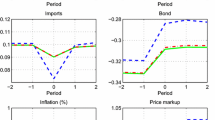Summary
Under a floating exchange rate system, exchange rates influence economic activity through their effect on the trade balance. Nevertheless, exchange rate movementsper se do not prevent integral fiscal and monetary policies from achieving a target for domestic economic activity24. At the same time, since the exchange rate continuously moves to preserve asset market equilibrium, the (potential) balance of payments may not be equilibrated when the authorities have attained their internal target. In that event, the continued movement in exchange rates may produce cycles in economic activity which in turn lead to exchange rate oscillations. Finally, the reader is warned that the introduction of inside and outside lags into the system may produce additional oscillatory behavior or even explosiveness, as Phillips demonstrated for the closed economy. However, these new possibilities would arise independently of the floating exchange rate system and could not be attributed to it.
Similar content being viewed by others
References
W. H. Branson: The Dual Roles of the Government Budget and the Balance of Payments in the Movement from Short-Run to Long-Run Equilibrium. Quart. J. of Economics90 (1976), pp. 345–367.
R. Dornbusch: Expectations and Exchange Rate Dynamics, Journal of Political Economy84 (1976), pp. 1161–1176.
R Dornbusch and P. Krugman: Flexible Exchange Rates in the Short-Run, Brookings Papers on Economic Activity (1976), pp. 537–575.
D. W. Henderson: Modelling the Interdependence of National Money and Capital Markets, American Economic Review67 (Papers and Proceedings) (1977), pp. 190–199.
D. W. Henderson: The Dynamic Effects of Exchange Market Intervention Policy: Two Extreme Views and a Synthesis, International Finance Discussion Papers No. 142 (Board of Governs of the Federal Reserve System) (1979) (forthcoming in Kredit und Kapital).
P. Isard: Exchange-Rate Determination: A Survey of Popular Views and Recent Models, Princeton Studies in International Finance No. 42 (1978), Princeton, N. J.
J. H. Levin: Capital Mobility and Endogenous Stabilization Policy Under Flexible Exchange Rates, Journal of Money, Credit and Banking9 (1977), pp. 572–585.
J. H. Levin: The Dynamics of Stabilization Policy Under Flexible Exchange Rates: A Synthesis of the Asset and Neo-Keynesian Approaches, Oxford Economic Papers32 (1980), pp. 411–427.
R. McKinnon: Portfolio Balance and International Payments Adjustment, in: R. A. Mundell and A. K. Swoboda (eds.): Monetary Problems of the International Economy, Chicago-London, 1969, pp. 199–234.
R. A. Mundell: International Economics, New York-London, 1968.
A. W. Phillips: Stabilization Policy in a Closed Economy, Economic Journal64 (1954), pp. 290–323.
Author information
Authors and Affiliations
Rights and permissions
About this article
Cite this article
Levin, J.H. Integral stabilization policy and flexible exchange rates. Zeitschr. f. Nationalökonomie 42, 61–78 (1982). https://doi.org/10.1007/BF01288455
Received:
Revised:
Issue Date:
DOI: https://doi.org/10.1007/BF01288455




